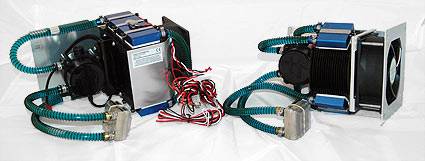Radical CPU Coolers from CoolIT
Introduction

Pretty much every PC enthusiast will agree that a PC can't be too cool or too quiet. While we might argue about the best way to make it happen, cooler and quieter is a worthwhile goal that we can't afford to ignore.
Many folks might consider liquid cooling to be the ultimate solution: indeed, a good liquid cooling system will be much quieter and cooler than the best air coolers money can buy. But while liquid cooling is vastly superior to air, it's far from being the most exotic cooling option out there. I'm sure you've heard about intrepid overclockers who use liquid nitrogen to cool their CPUs, and others have entirely submerged their PC components in non-conducting liquids in order to keep the temperature down. Another exotic method you may have heard of involves thermoelectric cooling devices, also known as TECs or Peltier coolers.
Words like 'Thermoelectric' and 'Peltier' certainly sound exotic, but the technology is quite old. Thermoelectric coolers are not that common in our homes because they are fairly inefficient; for example, they are less than 10% as efficient as the ideal refrigerator.
However, they do have their advantages. TECs use very simple solid-state technology and have no moving parts. TECs also have the capability to cool below the ambient room temperature. Contrast this with a water cooling system with a radiator and fans: the water in the radiator will never become cooler than the air in the room. A TEC, on the other hand, can lower the temperature below ambient.
Of course, the big problem with lowering the temperature of something below ambient is that you get condensation. For obvious reasons, you don't want to get condensation on your CPU. But if you combine liquid cooling with Thermoelectric cooling, you just might get the best of both worlds. Enter CoolIT's Freezone and Eliminator CPU cooling systems.

The main difference between the Freezone and Eliminator is the amount of cooling power. The Freezone is the more powerful of the two models, advertised to handle CPU's with a heat output up to 175 watts. The Eliminator is advertised to handle a heat output up to 125 watts.
Because of the Freezone's extra cooling prowess, it draws more power. The Freezone uses 6 TECs with a maximum power draw of 56 watts. The Eliminator on the other hand, uses 3 TECs with a maximum power draw of 40 watts.
Get Tom's Hardware's best news and in-depth reviews, straight to your inbox.
Price also separates these models. We found the more powerful Freezone online at about $290. Compare this with the Eliminator's online price of about $175. It will be interesting to see what the extra $100+ of the Freezone buys as far as performance.
Both the Freezone and the Eliminator are completely closed-loop liquid cooling systems that keep the temperature down with the help of thermoelectric cooling devices. As such, CoolIT claims they are smaller than a typical water cooling system, require much less maintenance, and are comparatively simple to set up.
We are happy to test these claims and see how the Freezone and Eliminator perform and install compared to a stock air cooler and a water cooling system, in this case Koolance's Exos-2.
Don Woligroski was a former senior hardware editor for Tom's Hardware. He has covered a wide range of PC hardware topics, including CPUs, GPUs, system building, and emerging technologies.